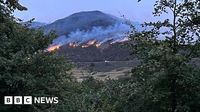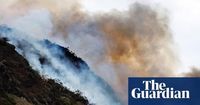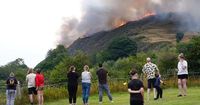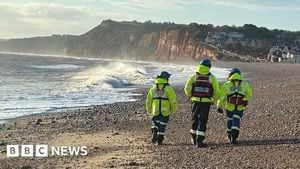Smoke billowed high above Edinburgh on Sunday, August 10, 2025, as a massive gorse fire tore across Arthur’s Seat, the city’s iconic hilltop landmark. The blaze, which erupted just after 4 p.m., quickly consumed large swathes of Holyrood Park, sending flames and panic through crowds of locals and tourists enjoying one of the busiest weekends of the year in the Scottish capital.
According to the Scottish Fire and Rescue Service (SFRS), the alarm was raised at 4:05 p.m., prompting a rapid response. Four fire appliances and specialist resources were dispatched to the scene to battle the rapidly spreading inferno. A spokesperson for the SFRS confirmed, “Operations control mobilised four fire appliances and specialist resources to the area where firefighters are working to extinguish a fire affecting a large area of gorse.” Despite the scale of the fire and the dramatic images flooding social media, there were no reported casualties as of late Sunday evening. “There are no reported casualties at this time and crews remain at the scene,” the SFRS reiterated in a statement carried by The Independent and EdinburghLive.
As the fire raged, police moved quickly to cordon off a significant portion of Holyrood Park, urging the public to steer clear. “Emergency services are responding to a fire at Arthur’s Seat in Edinburgh. Motorists and pedestrians are advised to avoid the area,” a Police Scotland spokesperson told EdinburghLive. The closure and warnings came as thick smoke drifted over the city, visible for miles and casting a shadow over the city’s famed skyline.
The timing could hardly have been worse. Edinburgh was bustling with visitors for its renowned August festivals, including the Fringe, and fans were pouring into the city for back-to-back Oasis concerts at Murrayfield Stadium. The band had already played to around 140,000 fans over two nights, with a third date scheduled for Tuesday. The influx of festival-goers and concert attendees added to the urgency, as authorities warned supporters leaving the Hibernian v Kilmarnock match to avoid the Willowbrae, Duddingston, and Holyrood areas due to the ongoing emergency.
Eyewitness accounts painted a picture of chaos and fear as the fire took hold. Nick Brice, a visitor from Brighton, recounted his harrowing experience to BBC Scotland News: “We could see this little plume of smoke on the ridge at the far side and it just got bigger and bigger. All of a sudden we could see these flames starting to come up and people noticed it spreading fast. The smoke started to really build and then these flames started to cover the ridge and we realised the wind was blowing it right towards us. We had to get down to the road fast because it was going to come across the whole area.” Brice added that he urged others still climbing the hill to turn back. “Now the whole hillside is covered in flames and smoke coming down over the path we walked.”
Other witnesses described scenes of people “running down the face of the hill” to escape the encroaching flames, with one telling Edinburgh Live, “There is a major wildfire on Arthur's Seat which is spreading rapidly. People are running down the face of the hill to get away from it and smoke is spreading really fast.” Videos and photos shared on social media showed the fire’s relentless advance, orange flames licking across the ridge and plumes of smoke blotting out the sky. By 10 p.m., the fire was still burning, nearly six hours after it began, though firefighters reported it was “nearly under control.”
The cause of the fire remains unknown, but its rapid spread was undoubtedly fueled by Scotland’s unusually hot and dry summer. The country experienced water scarcity in May, with Scottish Water warning that it was the driest start to the year since 1964. The SFRS had issued several wildfire warnings earlier in the year, and the Arthur’s Seat blaze followed a recent spate of wildfires in the Highlands—described by BBC News as “the biggest Scotland has ever seen.” In June, two fires in Dava Moor and near Carrbridge joined up to form a massive conflagration, requiring more than 100 workers from 30 businesses to help firefighters bring it under control.
Arthur’s Seat itself is no stranger to such incidents. In February 2019, a fire burned about 800 square meters of gorse on the Salisbury Crags, part of the same volcanic formation. That blaze took eight hours to control and brought similar scenes of smoke and disruption to the city. This time, the fire’s impact was magnified by the sheer volume of people in Edinburgh for the festivals, with smoke visible from as far away as the Easter Road football stadium. Fans in the stands posted videos of the blaze, their cheers and chants replaced by anxious commentary about the unfolding emergency.
Holyrood Park, where Arthur’s Seat rises steeply above the city, is a magnet for hikers and sightseers year-round. Its proximity to Edinburgh’s historic Old Town makes it a favorite destination for locals and tourists alike, who climb the hill for panoramic views of the city and beyond. On Sunday, those climbs turned into hurried descents as the fire forced evacuations and closed off access to one of Scotland’s most beloved beauty spots.
As night fell, the firefighting operation continued under challenging conditions. Images showed crews battling the blaze amid thick smoke, their silhouettes barely visible against the orange glow. A helicopter, believed to be operated by police, was seen circling the area, coordinating the emergency response. The SFRS even asked members of the public to stop calling to report the fire, assuring residents that crews were already on the scene and fully engaged.
The Arthur’s Seat wildfire is just the latest chapter in a summer that has tested Scotland’s emergency services and highlighted the growing risks posed by climate change and prolonged dry spells. While the immediate threat has been contained and, thankfully, no injuries reported, the incident has reignited concerns about the vulnerability of urban green spaces and the need for robust wildfire prevention and response strategies.
For Edinburgh, the fire was a stark reminder of nature’s unpredictability—even amid the celebrations and crowds of festival season, disaster can strike with little warning. As the smoke clears, the city will be left to assess the damage and reflect on how best to protect its treasured landmarks for the future.






